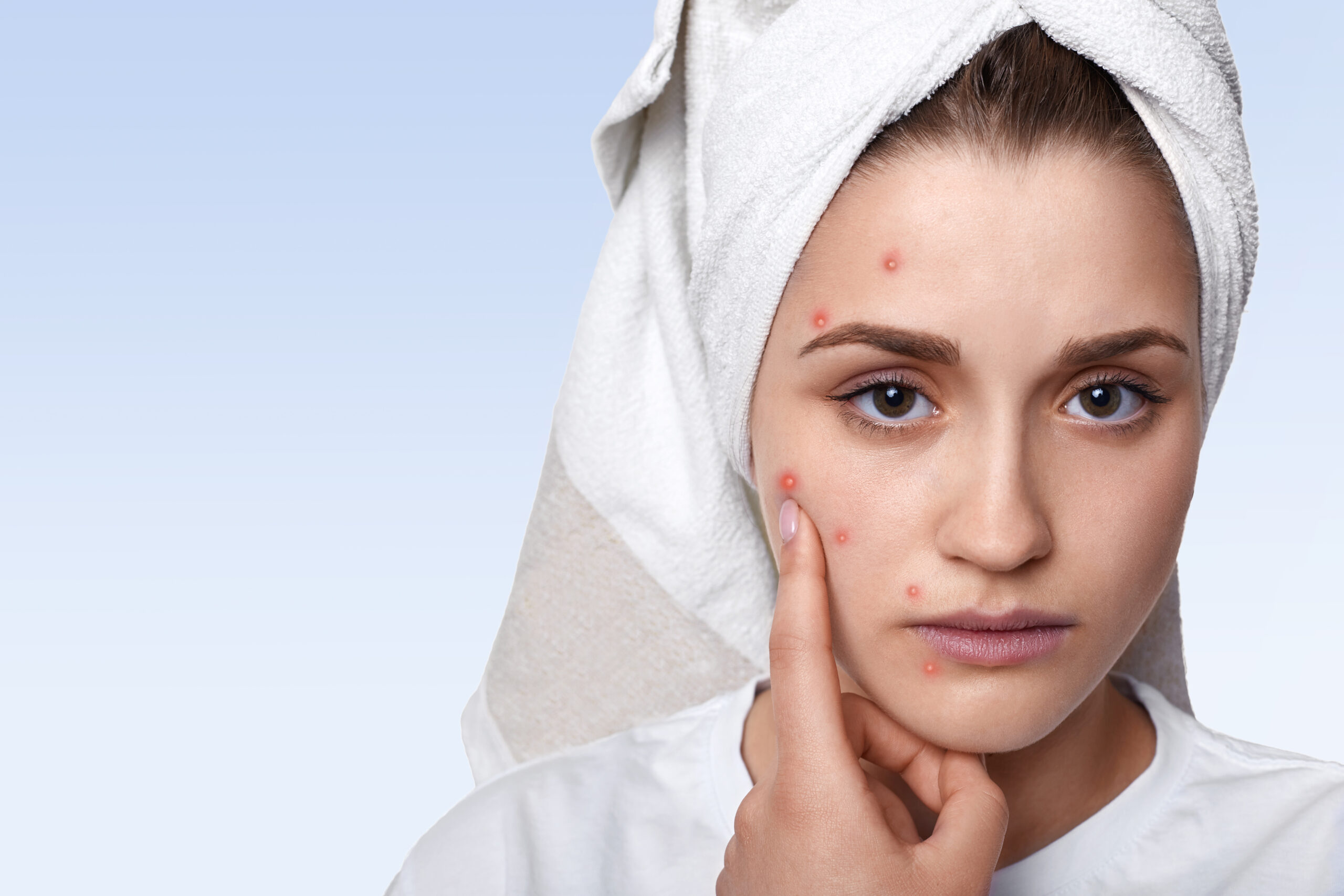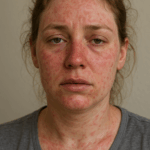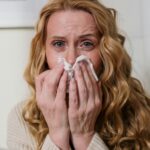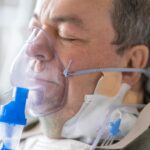At AskDoctor.ai, we have created this content to provide you with valuable knowledge about hormonal acne. Our goal is to offer both information and inspiration—helping you understand the condition while giving you hope and practical insights on how to manage and cope with it. You are not alone; through knowledge and community, we believe you can confidently navigate this journey.
Hormonal acne is a common skin condition that many individuals experience, particularly during puberty, pregnancy, and perimenopause. It occurs when fluctuations in hormone levels trigger an overproduction of oil in the skin, leading to clogged pores and breakouts. While acne is often associated with adolescence, it can affect people of all ages and is not exclusive to teenagers. Understanding the causes, symptoms, and treatment options for hormonal acne can help manage this condition more effectively.
What is Hormonal Acne?
Hormonal acne is a type of acne that occurs due to changes or imbalances in hormone levels. These fluctuations stimulate the sebaceous (oil) glands in the skin to produce excess oil. When the oil, combined with dead skin cells, clogs hair follicles, it can lead to the formation of acne lesions such as pimples, cysts, and blackheads. This condition often appears in areas with a higher concentration of sebaceous glands, such as the face, chest, and back.
Unlike regular acne, which can result from a variety of factors like poor hygiene or diet, hormonal acne is closely linked to hormonal changes. It typically manifests during specific life stages or situations, such as puberty, pregnancy, menstruation, and menopause. Hormonal acne can be persistent and challenging to treat, requiring a tailored approach.
Causes of Hormonal Acne
Hormonal acne is primarily caused by fluctuations in hormone levels. These fluctuations can occur during different stages of life, affecting both men and women. The most common causes of hormonal acne include:
Puberty
Puberty is one of the most common times for hormonal acne to appear, as it is when significant hormonal changes take place. During puberty, the body changes both estrogen and testosterone levels. Testosterone stimulates the sebaceous glands, leading to increased oil production. When this oil mixes with dead skin cells, it can block pores and cause acne. This is why hormonal acne is often seen in teenagers, particularly around the chin, jawline, and forehead.
Menstrual Cycle
Many women experience a flare-up of acne around their menstrual cycle. Studies indicate that between 50% to 80% of menstruating women experience acne flare-ups premenstrually. Hormone levels fluctuate throughout the menstrual cycle, with testosterone levels spiking in the days leading up to menstruation. This increase in testosterone can stimulate the sebaceous glands to produce more oil, leading to clogged pores and breakouts. Women may notice acne worsening during the second half of their cycle, particularly on the chin, jawline, and cheeks.
Pregnancy
Pregnancy causes significant hormonal changes, particularly an increase in progesterone levels. This hormone plays a key role in supporting a pregnancy, but it also stimulates oil production in the skin. For some women, this can lead to the development of acne during pregnancy. While some women experience clear skin due to pregnancy-related hormonal changes, others may struggle with acne outbreaks.
Polycystic Ovary Syndrome (PCOS)
PCOS is a condition that affects a woman’s hormone levels, causing an imbalance that leads to higher levels of androgens (male hormones like testosterone). A study reported that the pooled prevalence of acne among adult women with PCOS was 76% when using the NIH definition and 36% according to the Rotterdam criteria, both significantly higher than in non-PCOS counterparts.
The overproduction of testosterone stimulates the sebaceous glands, resulting in excess oil production and acne. Women with PCOS often experience other symptoms, such as irregular periods, weight gain, and excess hair growth.
Perimenopause and Menopause
As women approach perimenopause and menopause, they experience a decline in estrogen levels, while testosterone levels may remain constant or even increase. This imbalance in hormones can contribute to acne outbreaks, especially around the chin, jawline, and neck. Menopausal acne is often similar to acne seen in adolescents, but it tends to be more concentrated on the lower face.
Birth Control Pills and Hormonal Medications
Certain birth control methods, including hormonal contraceptives, can impact acne. Some birth control pills can help regulate hormone levels, which can, in turn, reduce the severity of acne. However, others can increase the production of androgens, leading to an increase in acne. Similarly, other medications like corticosteroids or hormone replacement therapy (HRT) may cause acne as a side effect.
Stress
Stress does not directly cause hormonal acne, but it can exacerbate it. When we are stressed, our body produces more cortisol, a hormone that can trigger the sebaceous glands to produce more oil. This excess oil, combined with other factors, can worsen acne symptoms. Stress can also make hormonal fluctuations more pronounced, triggering acne flare-ups.
Symptoms of Hormonal Acne
Hormonal acne has a distinct pattern compared to other types of acne. The key symptoms include:
- Breakouts around the Jawline and Chin: Hormonal acne tends to appear on the lower face, particularly the chin, jawline, and neck. This is because the hormonal fluctuations that cause acne often affect the sebaceous glands in these areas.
- Deep, Painful Cysts: Unlike the smaller pimples often seen with other types of acne, hormonal acne is often characterized by large, painful cysts or nodules under the skin. These cysts can be red, swollen, and tender to the touch, and they are often more difficult to treat.
- Frequent Outbreaks: Hormonal acne tends to occur in cycles, with flare-ups happening regularly, typically in alignment with the menstrual cycle or other hormonal changes.
- Persistent Acne: Hormonal acne can be stubborn and persistent. While it may clear up in some areas of the face or body, it tends to return as hormonal levels fluctuate, leading to recurring breakouts.
Treatment for Hormonal Acne
While hormonal acne can be frustrating and persistent, several treatments can help manage and reduce the severity of symptoms. The best approach depends on the individual and their specific condition, but common treatment options include:
Topical Treatments
- Benzoyl Peroxide: Benzoyl peroxide is an effective topical treatment for acne because it helps to kill acne-causing bacteria and reduce inflammation. It can be found in cleansers, creams, and gels and is commonly used for managing both hormonal and non-hormonal acne.
- Salicylic Acid: Salicylic acid works by exfoliating the skin and unclogging pores. It helps prevent the formation of new acne lesions by removing dead skin cells. It is a common ingredient in acne treatment products like cleansers, toners, and spot treatments.
- Retinoids: Retinoids, such as tretinoin or adapalene, are vitamin A derivatives that help regulate skin cell turnover, preventing clogged pores. They are effective for both reducing acne outbreaks and minimizing scarring. Retinoids should be used cautiously, as they can increase skin sensitivity.
Oral Medications
- Hormonal Therapy: For women, hormonal therapies such as birth control pills or anti-androgen medications (like spironolactone) can help regulate hormone levels and reduce the severity of hormonal acne. These treatments can reduce the production of excess sebum, preventing clogged pores and acne formation.
- Antibiotics: In some cases, oral antibiotics like doxycycline or minocycline may be prescribed to help control acne-causing bacteria and reduce inflammation. These antibiotics are often used for moderate to severe acne, though they are typically not a long-term solution.
- Isotretinoin: For severe and persistent hormonal acne, oral isotretinoin (commonly known as Accutane) may be prescribed. This powerful medication works by reducing oil production, preventing clogged pores, and addressing acne at its root. However, isotretinoin comes with significant side effects and should only be used under a doctor’s supervision.
Lifestyle Modifications
- Diet and Nutrition: Some studies suggest that high-glycemic-index foods, like sugary and processed foods, can worsen acne. Incorporating a balanced diet with whole grains, fruits, vegetables, and healthy fats can help balance hormones and reduce acne outbreaks.
- Stress Management: Reducing stress through activities such as yoga, meditation, or regular exercise can help manage cortisol levels and prevent stress-induced acne flare-ups.
- Proper Skin Care: Maintaining a consistent skincare routine is essential. Using gentle, non-comedogenic products that do not clog pores, and avoiding harsh scrubbing, can help keep acne under control. Regularly washing the face with a mild cleanser helps remove oil and debris that may contribute to breakouts.
Professional Treatments
- Chemical Peels: Chemical peels can help exfoliate the skin, unclog pores, and reduce acne scars. This treatment should be done by a dermatologist or licensed professional.
- Laser Therapy: Certain types of laser therapy can reduce oil production and treat acne scars. Laser treatments like fractional laser and blue light therapy are effective in reducing acne lesions and improving skin texture.
Managing Hormonal Acne Caused During Pregnancy
Reddit User Cedar_the_cat talks about how she managed her hormonal acne. She opted for spironolactone for a few years to manage her hormonal acne. When she decided to have a baby at 34, she was concerned about stopping the medication. However, she became pregnant immediately after discontinuing spironolactone, and because of the quick transition to pregnancy hormones, she didn’t experience any breakouts during that time. Since then, she hasn’t had significant hormonal acne, even though there was a three-year gap between pregnancies and no prescription medications were used.
Leveraging The Power of Antibiotics
Another Reddit User shares her experience with hormonal cystic acne. She had massive flare-ups on her jaw and cheeks in the week leading up to her period and found that doxycycline was a game-changer for her skin. Then she started taking one 75mg caplet twice a day with food, typically for four days each month (occasionally extending to five or six days if needed). She starts the medication as soon as she notices pimples forming under her skin, and within those few days, the cysts surface and can be easily treated with an over-the-counter product like benzoyl peroxide. Doxycycline has continued to be her go-to solution for acne, and she appreciates that it’s a non-hormonal medication, meaning it doesn’t interfere with her hormone levels.
Manani’s Visual Diary
You can check out Manani’s experience and journey with hormonal acne on this YouTube video.
Say Goodbye To Hormonal Acne: Knowledge Is The First Step Toward Acne Positivity
Hormonal acne can be a challenging and persistent condition, but with the right treatments and lifestyle changes, it is possible to manage and reduce its impact. Understanding the causes of hormonal acne and how hormones influence skin health is key to addressing this issue effectively. From topical treatments and oral medications to lifestyle modifications like stress management and a balanced diet, there are many strategies to help control hormonal acne and restore skin health. If you’re struggling with persistent acne, it’s always a good idea to consult with a dermatologist to determine the best course of treatment for your unique skin.









Leave a Reply